The German offensive in the Ardennes was remembered by American soldiers as the fiercest battle they had ever fought in Europe. Winter conditions, numerous crimes and fierce fighting bring to mind the nightmare of the Eastern Front. These photos reflect the drama of the fatal struggle at the turn of 1944 and 1945.
The offensive in the Ardennes was Hitler's last chance to save German territory from direct invasion and halt defeat. The commanders also knew about it, even the soldiers fed on the propaganda sensed it, so they fought with particular ferocity. But even the Americans, unprepared to withstand the surprise attack, showed great determination in many places, which allowed the advance of the Third Reich's troops to slow down.
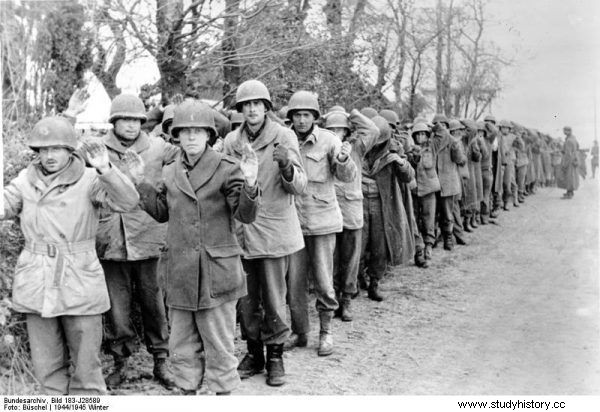
American soldiers in German captivity, December 22, 1944 (photo:Bundesarchiv, Bild 183-J28589 / CC-BY-SA 3.0).
The German offensive in the Ardennes began on December 16, 1944 and came as a complete surprise to the overconfident Western allies, who were so far thinking of their own plans to attack the Third Reich. Some commanders disregarded reports from the front at first, although V-1 missiles were flying overhead . Deprived of air support due to bad weather, and often forced to defend too long sections of the front, American soldiers were unable to stop the Wehrmacht advance. The Germans took many prisoners of war in the first phase of the fighting.
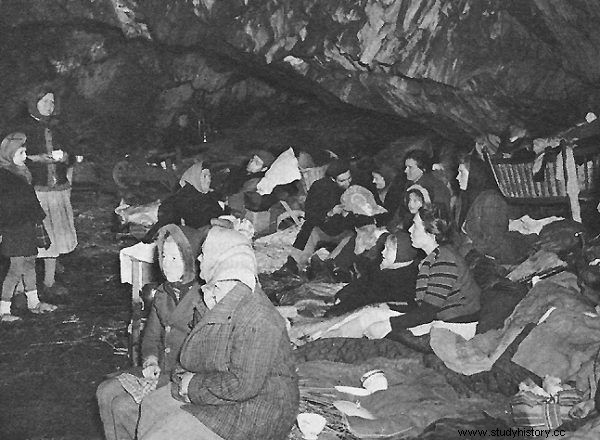
Residents of the Belgian Schönberg seeking refuge in a cave (photo from the collection of the United States Army Center of Military History, public domain).
The Germans knew that American soldiers liked to spend the night in houses, barns, etc., so they started their offensive by firing at civilian buildings near the front lines. The few inhabitants who were allowed to remain in the vicinity of enemy positions could only watch helplessly as their belongings burned and the soldiers, roused from sleep, searched frantically for their equipment. Fighting in the area of St. The Vith, of which Schoenberg is a part today, ran from 17 to 23 December, and it is no wonder that the people there were looking for a place offering some protection from fire.
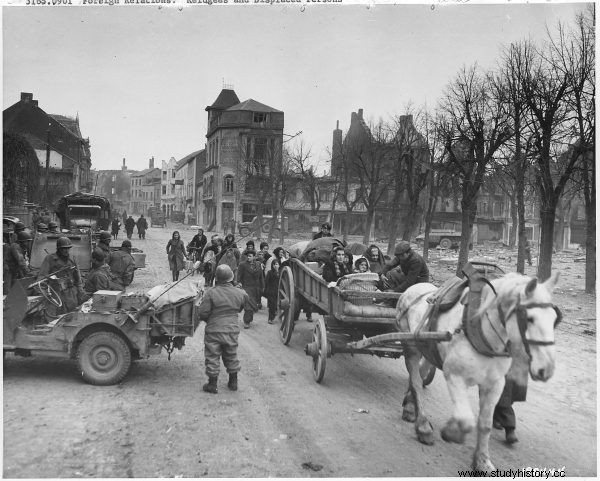
Belgian refugees leave the city of Bastogne (Photo:National Archives and Records Administration, public domain).
The German offensive also surprised people living a little further from the front lines, who could hope that the nightmare of the war was over. Inhabitants of endangered towns began to flee en masse, intensifying the chaos on the roads. Revenge was often feared for the activities of the resistance movement, whose members had attacked the retreating Wehrmacht units just a few months earlier. The refugees were sometimes treated with suspicion by American soldiers who suspected the refugees of pro-German sympathies and feared disguised saboteurs.
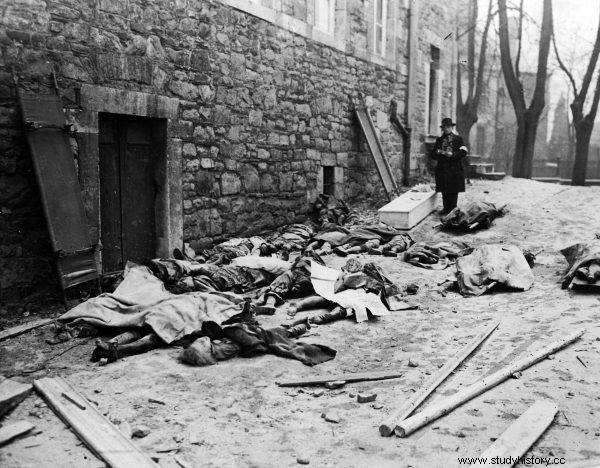
Belgian civilians murdered by the Germans (photo:National Archives and Records Administration, public domain).
It turned out that the fleeing inhabitants of the areas threatened by the Germans had good reasons to fear the barbarism of the approaching invaders. During the fighting in the Ardennes, many crimes against the civilian population took place. On December 19, in Stavelot about 130 people were murdered, mostly women and children . On Christmas Eve, 24 December, 34 young men were shot in the village of Bande. On the wall of the house where the dead were buried, the Germans left the inscription Revenge for the death of our German heroes who died by the hand
Belgians .
Attention! You are not on the first page of the article. If you want to read from the beginning click here.
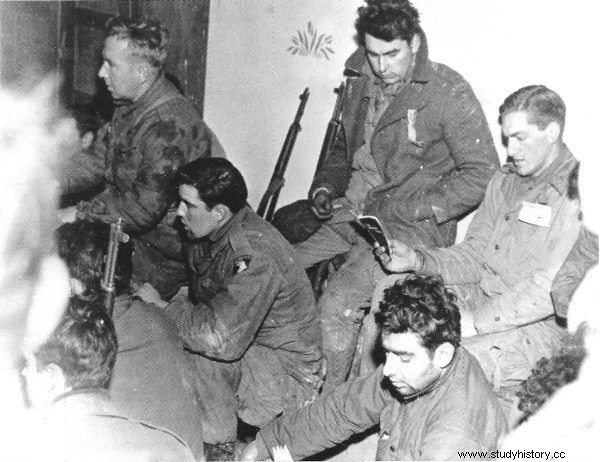
American paratroopers from the 101st Airborne Division in Bastogne sing Christmas carols on Christmas Eve (Photo:U.S. Army, National Archives and Records Administration, public domain).
From 19 to 27 December 1944, fighting continued for the city of Bastogne, which was a key road junction in southern Belgium. The Germans were outnumbered by two times, the defense was prepared literally at the last minute, and the rescue could not be counted on for many days. Additionally, the Germans intercepted the medical post of the US 101st Airborne Division, which meant that there was a shortage of doctors, medical equipment and medicines for wounded soldiers. Despite this, the Nazis failed to break through the Allied positions, largely due to a change in the weather that allowed the defenders to provide air supplies.

Identification of the bodies of mascara victims near Malmeda (Photo:U.S. Army, National Archives and Records Administration, public domain).
Not only civilians were victims of German brutality. Also, allied soldiers taken prisoner had to reckon with the fact that instead of being sent to a POW camp, they would be simply shot. The massacre that took place near the Belgian city of Malmedy on December 17, 1944, became especially famous. Members of Kampfgruppe Peiper from the 1st SS Panzer Division murdered 84 captured Americans at the intersection in Baugnez. The soldiers of the same unit are responsible for a combined total of over 350 American prisoners of war and many civilians, including the aforementioned Stavelot crime.

American prisoners of war murdered in Honsfeld by Kampfgruppe Peiper. German soldier of the covenant 'captured' boots (photo:U.S. Army, National Archives and Records Administration collection, public domain).
Shortages in supplies in the Nazi army made Wehrmacht and SS soldiers eagerly wear the acquired shoes or other uniforms. Of course, they did not always come from the murdered prisoners, and those who died in combat were also plundered. Nevertheless, when the Yankees captured a German wearing an American coat or carrying cigarettes from overseas, they often treated him like a criminal or a saboteur in disguise and killed him in revenge on the spot . It also happened that a captured soldier, who had grazed on someone else's shoes, was chased barefoot in the snow until his feet were frostbitten and required amputation.
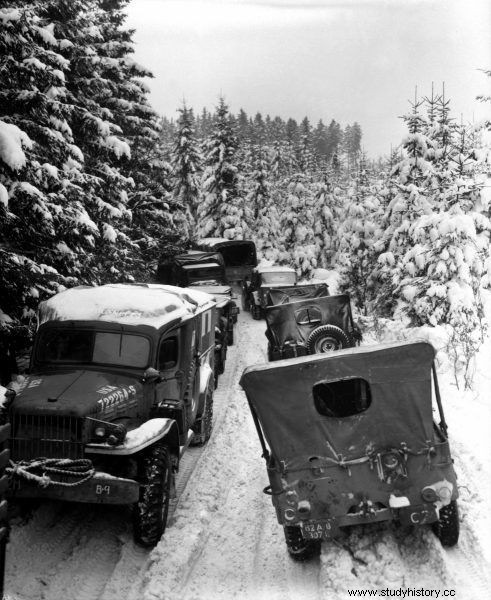
Trucks and cars of the US 87th Infantry Division on a forest road nearby in Belgium (photo:Norbuth, National Archives and Records Administration collection, public domain).
The Ardennes is a mountainous, densely wooded area with few good roads. In combination with bad weather and deep snow and mud, these conditions made it difficult for the Germans to attack and gain the right momentum from the very first day of the offensive. Traffic jams were forming in many places, compounded by poor traffic management. Even General Model himself started on December 19 , furious at the too slow progress of his troops. All these troubles contributed to the aggravation of another problem:fuel shortages not reaching the front units on time.
This article has more than one page. Please select another one below to continue reading.Attention! You are not on the first page of the article. If you want to read from the beginning click here.

American walkers in a forest outside Amonines, Belgium (Photo:Braun, U.S. Army, public domain).
Of course, snow was a problem not only for the cars, but most of all for the fighting soldiers. Frostbites, "trench foot", icing of weapons, sights, headphones and other equipment became everyday life at the front . The cooling covers of the American HMGs froze and exploded, betraying the enemy's positions. Dysentery appeared - the result of the inability to clean the canteens properly. The Americans found one good use for the snow, however:they mixed it with lemon lemonade, so they could enjoy a sorbet substitute.
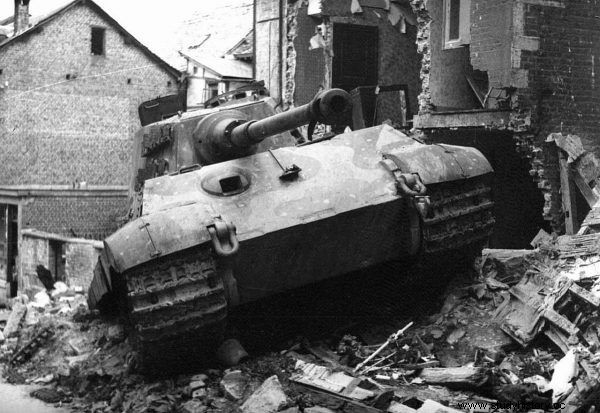
King Tiger abandoned by the crew in Stavelot after being hit by a bazooka and stuck in a rubble as the driver tried to back off (Photo:National Archives and Records Administration, public domain).
During the fighting in the Ardennes, the King Tiger was a real terror to American soldiers, especially the less armored and armed Shermans. In the sources, you can find many stories about encounters with German "monsters", able to withstand multiple hits from too small-caliber cannons. On the other hand, there are many indications that the Yankees often confused these tanks with the Pzkpfw IV, which had a similar silhouette. This is probably where at least some of the reports of the destruction of the Tigers came from, such as the elimination of one of them by the M8 Greyhound armored car and its 37mm gun.
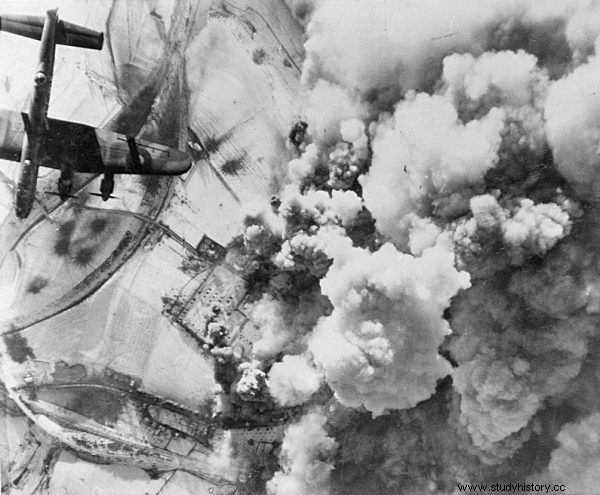
RAF Lancaster bombers attack German positions in St. Vith, December 26, 1944 (photo:public domain).
Although in December 1944 the Allies had an overwhelming advantage in the air, at the beginning of the German offensive they could not use this advantage due to unfavorable weather. Even before the fighting began, it prevented the proper reconnaissance, which made it much easier for the Nazis to prepare for the offensive. On December 23, however, conditions improved, and the bombing of the Wehrmacht's supply lines finally stopped the offensive in the Ardennes.

A young SS man taken prisoner by American soldiers (photo:U.S. Army, National Archives and Records Administration, public domain).
After the Malmedy massacre and reports of other German crimes, SS men captured by the Americans could rarely count on mercy and treatment in accordance with the Geneva Convention, but were repeatedly killed. The largest crime of its kind committed by U.S. soldiers The Army took place on January 1 in Chenogne, when about 60 German prisoners of war were shot. After the fact, the matter was swept under the carpet, as requested by General Patton , which he wrote in his diary: There were some unfortunate incidents, as a result of which the prisoners were killed. I hope we can cover it up .
***
The descriptions for the photos are based on the book by Anthony Beevor "Ardennes 1944. Hitler's last chance" (Horizon Mark 2016).
